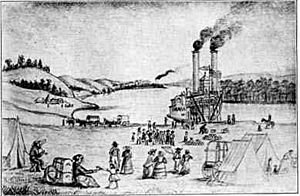Winter Quarters (North Omaha, Nebraska) facts for kids
Quick facts for kids
Winter Quarters
|
|
|---|---|
|
Former LDS camp
|
|

Mormons at Winter Quarters
|
|
| Country | United States |
| State | Nebraska |
| Vacated | December 1848 |
| Population
(September 1846)
|
|
| • Total | 3,800 |
Winter Quarters was a temporary settlement where about 2,500 members of the Church of Jesus Christ of Latter-day Saints lived. They stayed there during the winter of 1846–47. They were waiting for better weather to continue their journey west.
Before Winter Quarters, they had a smaller camp called Cutler's Park, about 3½ miles away. At Winter Quarters, the Church members built over 800 cabins. This settlement was located in what is now North Omaha, overlooking the Missouri River. People lived there until 1848.
Contents
Life at Winter Quarters
The Latter-day Saints had been forced to leave their homes in Nauvoo, Illinois. They had to leave quickly, so they couldn't bring many supplies. A man named Thomas L. Kane helped them. He got permission from the U.S. government for the group to stay on land belonging to the Omaha Tribe. This land included the site of Cutler's Park.
Life was tough at first. For the first month, the pioneers lived in tents. The men worked hard to gather hay, find water, and care for their cattle.
Building a New Home
There were some disagreements between the Oto and Omaha tribes about using the land. Because of this, the Latter-day Saints moved their camp three miles east. This new spot was on a hill overlooking the Missouri River. Here, they built cabins and sod houses to prepare for winter. Sod houses were homes made from blocks of earth and grass.
One group of cabins was called Kimball Row. It had thirteen cabins built next to each other. The homes of Church leaders Heber C. Kimball and Newel K. Whitney were at each end.
Trading for Supplies
The Latter-day Saints traded with Native American tribes and other settlements. They traded with people in northern Missouri and Iowa. They exchanged things like household goods and a little money for food. This included hogs, grain, vegetables, and supplies for their journey. Young Church members also made things to sell, like willow baskets and washboards.
The Church also used its money to build a gristmill. This mill used water power to grind corn into cornmeal. It was a very important building for the community.
Challenges and Sickness
Even with trading, the food at the camp was simple. People mainly ate corn bread, salted bacon, and a little milk. Sometimes they had fresh game or meat.
Many people got sick. Scurvy, a disease caused by not having enough vitamin C, was a big problem. People called it "blackleg" back then. Eating Missouri potatoes and horseradish helped a little. But everyone still needed more fresh vegetables.
Other diseases like tuberculosis, malaria, and fevers also affected the camp. A Church member named Louisa Barnes Pratt wrote about her experiences:
I hired a man to build me a sod cave. He took turf from the earth, laid it up, covered it with willow brush and sods. Built a chimney of the same ... I paid a five dollar gold piece for building my sod house, 10 × 12 ... A long cold rain storm brought more severely again the chills and fever. These with scurvy made me helpless indeed! ... Many of my friends sickened and died in that place, when I was not able to leave my room, could not go to their bedside to administer comfort to them in the last trying hours, not even to bid them farewell. Neither could I go to see their remains carried to their final resting place where it was thought I would shortly have to be conveyed.
Records show that from September 1846 to May 1848, 359 residents died from various diseases.
The Florence Mill
Brigham Young oversaw the building of the Florence Mill. This mill is believed to be the only building still standing that was built by the Latter-day Saint camp. The settlers needed a mill to grind their grains into flour.
Construction started in the fall of 1846 next to Turkey Creek (later called Mill Creek). It was finished by the spring of 1847 and cost $3,000. Brigham Young later sold the mill. Other settlers used and renovated it for many years. Today, you can still see parts of the original building methods in the Florence Mill.
Winter Quarters Today
The area where Winter Quarters once stood is now part of Florence. Florence is a community within North Omaha.
Today, several places remember the pioneer community:
- The Mormon Pioneer Cemetery
- Cutler's Park
- The Mormon Trail Center
- The Mormon Pioneer Memorial Bridge
The Winter Quarters Nebraska Temple was built there and dedicated on April 22, 2001.
See also


